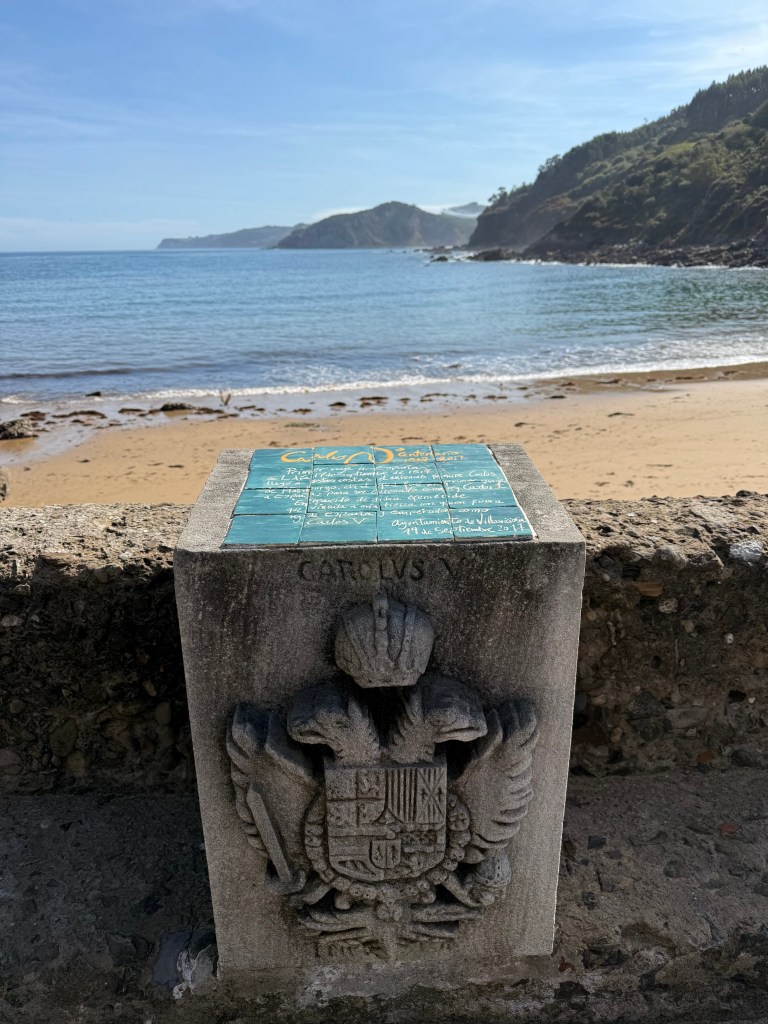From Llanes to Tazones: Following in the Wake of an Emperor
From Llanes to Tazones: Following in the Wake of an Emperor
— By David Eugene Perry; photos by Alfredo Casuso
Last night in Llanes, we stopped before a bronze plaque set into a sunlit yellow wall — its inscription recalling a moment five centuries ago when King Carlos I of Spain, soon to become Emperor Charles V, spent the nights of September 26 and 27, 1517, in this very town. Only seventeen, he had just arrived from Flanders to claim his inheritance as Spain’s first Habsburg monarch.

That small plaque — a replica of an earlier wooden one — set our imagination in motion. It reminded us that Charles’s arrival had not been a triumphant parade but rather a journey born of chance and weather. His fleet, bound for Santander, was blown off course by storms and forced to land in the small Asturian fishing village of Tazones, not far from Llanes.
⸻
Ruta Mañanga, Porrúa
This morning, tracing his route, we drove west from Llanes to Porrúa, where we hiked the Ruta Mañanga — a two-hour trail through meadows, chestnut groves, and sea-view ridges. At every turn, Asturias offered up a gasp-worthy tableau of green, sea, and mountain air. Veterans of hundreds of hikes over 27 years, Alfredo and I easily listed this among our “top five” for scenic beauty, alongside favorites in Grazalema and Orvieto.
Afterward, we stopped at the Museum of Asturian Rural Life, an intimate and thoughtful collection that captures the region’s centuries-old farming and fishing traditions.

⸻
Tazones: Where History Met the Sea
A short drive brought us to Tazones, where on September 19, 1517, Charles I first stepped onto Spanish soil.
Today the town remains a pocket-sized harbor of whitewashed and color-trimmed houses, fishing boats bobbing in the tide, and gulls circling over the Plaza del Riveru, once the center of the whaling and fishing trade.

Walking uphill through narrow cobbled streets, we paused at the Mirador de Les Muyeres, dedicated to the women who once watched from above for the fishing boats’ return. Nearby stands a touching wooden statue of a woman mending nets — a tribute to their endurance and central role in village life.

⸻
The Shellfish House and the Church of San Miguel
The Casa de las Conchas, the famous “shellfish house,” remains one of the most photographed buildings in Asturias — its entire façade covered in seashells, decorated with bright red balconies, lifebuoys, and a pirate flag fluttering above.

Just beyond stands the small Church of San Miguel de Tazones, whose interior holds two poignant treasures: a beautifully preserved statue of Saint Michael and a plaque telling the story of El Niño Manolín, a small sacred image saved from the flames when the church was burned in 1936 during the Spanish Civil War.

⸻
Lunch by the Sea
We ended our visit at Mar-Bella, a seaside café near the harbor. Lunch was simple and perfect: navajas (razor clams), cabracho (a delicious pâté made of scorpionfish) and a chipirone (a small grilled squid) all paired with Asturian cider poured in the traditional way.

In Asturias, cider isn’t just poured; it’s escanciada — a quick, precise motion that transforms the drink with a bit of air, a bit of theater, and a lot of local pride. Here it was done in an on-table device: adorable.
⸻
Following the Emperor’s Path — and the Dinosaurs’:
Charles’s 1517 route took him from Tazones inland to Villaviciosa, and then to Avilés, Gijón, Ribadesella, and Llanes, before continuing toward Valladolid. Along these same rugged coastlines, he first met the land he would rule.
We also discovered that Tazones hides another layer of history — or prehistory — beneath its cliffs: the Yacimiento del Puerto de Tazones, part of the Monumento Natural de los Yacimientos de Icnitas de Asturias, preserves fossilized dinosaur tracks from the Jurassic period, some 150 million years ago.

Today, ours was a smaller voyage — just a drive, a hike, and a meal — but in the steps of emperors and dinosaurs.